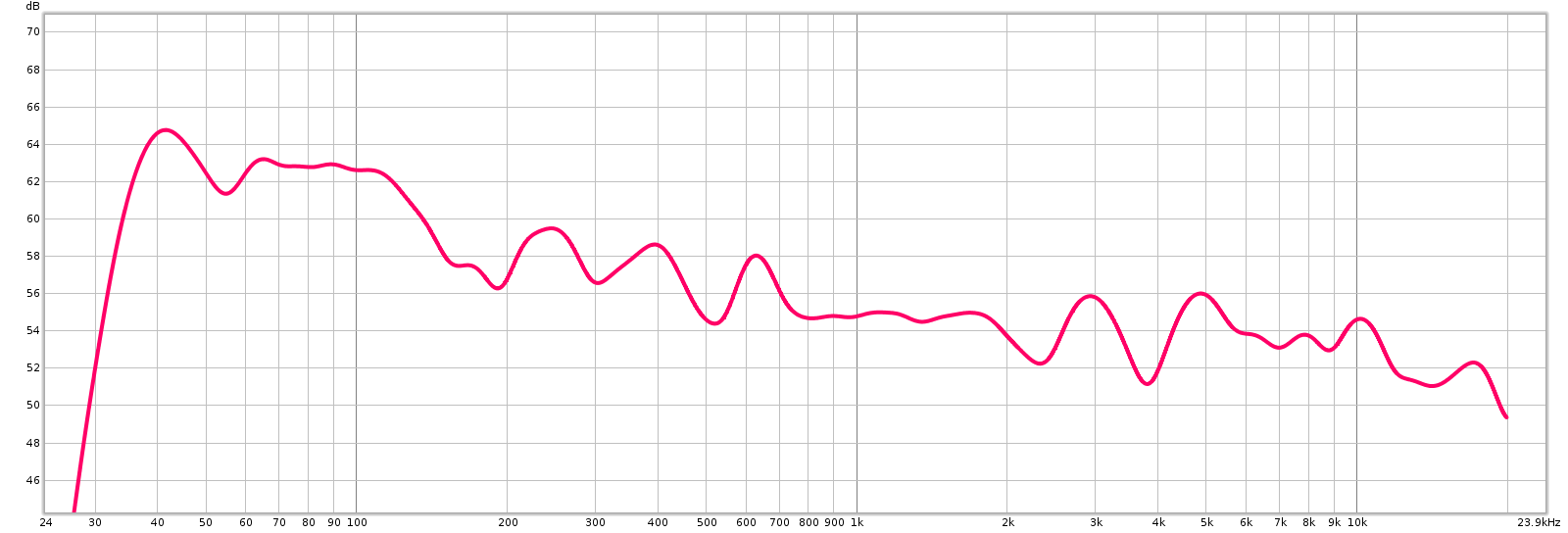
This is the frequency response measured at the listening position in my room/ The curve looks wobbly only because the graph is 2 dB per line.
I'll provide a brief description of each, followed by general observations. It's often debated whether the room and speakers are the most important part of any audio system. I believe they are so I'll cover them first.
First and most importantly - the room. I used a studio mic (Rode NT1A) at my listening couch to measure 1/3 octave warble tones, loaded into Audacity, corrected for mic response, to find the frequency response at the listening position.
I then rearranged the speakers and room, used RPG Acoustic Foam (4 layers thick along the wall behind the listener) and built my own tube traps (21" diameter by 7' tall in the rear room corners), re-measuring each change, to get the response as flat and smooth as possible.
I ended up with this:

This is the frequency response
measured at the listening position in my room/
The curve looks wobbly only because the graph is 2 dB per line.
This is their actual response in my listening room - not some theoretical specification from a manufacturer's marketing department. They are flat within 4 dB from 30 Hz to 20 kHz, following a linear -1.5 dB / octave slope recommended by psychoacoustic audio research. More measurements here.
Below about 500 Hz, the smooth bass response is due mainly to the big tube traps that I built.
My power amp is an Adcom 5800.

It has plenty of juice to drive my big inefficient Magnepan speakers.
It operates in high bias class AB for low noise and distortion with plenty of power.
It's symmetric class A up to 10 watts output, then becomes AB to its rated output.
It draws up to 1.8 kW from the wall while delivering over 400 watts of continuous power
to each speaker, with 2 dB of headroom which amounts to about 1300 watts of peak power output.
Its noise floor is below -100 dB with low distortion
and frequency response within 0.25 dB throughout the audible bandwidth.
The 5800's sound is neither "warm", nor "bright", but simply neutral.
The only problem I've had with this amp over the years is the power switch. Every 5 years or so it fails, leaving the amp permanently ON. The switch is an inexpensive part (about $20) and easy to replace. I've owned this amp for about 20 years.
My preamp is an Oppo HA-1. It is a DAC, headphone amp and preamp. Its analog stage is single ended class A balanced both to headphones, and the line stage to the power amp. Here's my review of the Oppo.
NOTE: I recently said "good-bye" to the 10 kOhm ladder stepped passive attenuator that I used to use as a preamp.
Next, the Oppo BDP-83 disk player. It plays any kind of disc with vanishingly low distortion. I run the optical digital audio output to the HA-1.
I no longer have a turntable. After many years of vinyl listening - I've gone fully to the dark side! I archived all my LPs to CD with high quality transfers.

My Tuner is a
Sangean HDT-1X.
It is an HD Radio tuner with a unique design.
You can read more about it
here.
It has excellent sensitivity, tunes HD Radio stations, and has good sound quality.
It has a digital optical output which connects directly to my CD burner,
so I can bypass unnecessary D->A and A-> stages when recording.
My speaker cables are regular old 12 gauge fine stranded copper with locking banana plugs soldered on.
Most of my cables, both analog & digital, come from Blue Jeans Cable. Excellent quality at reasonable prices, and built right here in Seattle, down the street from me.